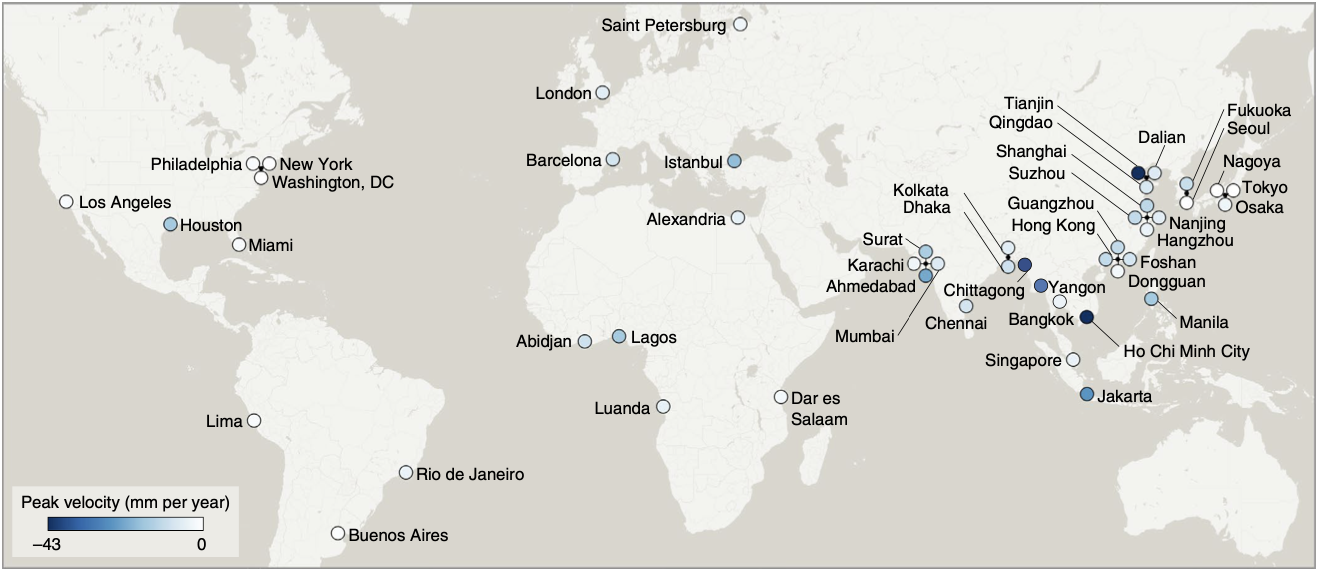Follow us on Telegram for the latest updates: https://t.me/mothershipsg
A study by researchers at the Nanyang Technological University (NTU) has found that rapid land sinking is exacerbating the problem of sea level rise, the university announced in a news release.
The research was led by NTU in collaboration with an international team of scientists from University of New Mexico, ETH Zürich, and NASA’s Jet Propulsion Lab managed by the California Institute of Technology.
Fast-sinking cities concentrated in Asia
To measure the rate of sinking land, the study examined processed satellite images of 48 coastal cities from 2014 to 2020 using a cloud-based processing system called Interferometric Synthetic Aperture Radar (InSAR).
The coastal cities were selected based on population size (at least 5 million in 2020) and proximity to the coast (at most 50km from coast).
Singapore is one city included in the study.
The study found that the median sinking speed across the 48 cities was 16.2mm per year.
Some land areas had sinking speeds of as much as 43mm per year.
 Cities looked at as part of the study. Image via NTU.
Cities looked at as part of the study. Image via NTU.
Cities that are experiencing the fastest rates of sinking are concentrated in Asia, especially Southeast Asia, the study found.
Cities with the fastest sinking rates on average include:
- Tianjin, China
- Ho Chi Minh City, Vietnam
- Chittagong, Bangladesh
- Yangon, Myanmar
- Jakarta, Indonesia
- Ahmedebad, India
Many of the cities with high sinking rates are "rapidly expanding megacities", the study noted.
Land sinking exacerbates the problem coastal cities face with rising sea levels as glaciers and ice sheets continue to melt.
As the rate of land sinking increases, the relative rate of sea level rise will increase as well.
The current estimated rate of sea level rise is 3.7mm per year on average.
The study's results also concluded that the rate of land sinking had a higher variability than current estimates by the International Panel on Climate Change.
This means that in some cases, the rate may be much higher than thought.
Study enables future research and policymaking
First author of the paper Cheryl Tay, a PhD student at NTU's Asian School of the Environment and Earth Observatory of Singapore, elaborated on the impact of the study's findings in NTU's news release.
"Rapid sinking of the land is frequently caused by groundwater extraction. This is concerning in Asia where many coastal cities are now centres of growth, and there is high demand for groundwater extraction to meet the water needs of growing populations."
She noted that by estimating the speed at which densely populated coastal cities are sinking, it can "constrain projections of coastal flooding in the coming decades".
Co-author and NTU Professor of Earth Sciences Emma Hill remarked that the findings enable affected communities and policymakers to identify high risk regions and "take action to address coastal risks".
The study was carried out in support of NTU 2025 strategic plan, which aims to address challenges on sustainability and accelerate research discoveries into innovations that mitigate human impact on the environment, the news release wrote.
It also contributes to the Singapore National Sea Level Programme (NSLP), which aims to equip policy makers with the information they need to protect Singapore’s coasts through research.
Singapore's efforts
During the 2019 National Day Rally, Prime Minister Lee Hsien Loong announced that the gravest threat Singapore faces from climate change, aside from food shortages and new diseases, is rising sea levels.
Despite Singapore's efficient drainage system, which has generally kept flooding to a minimum, more needs to be done to prepare for a future of higher tides, heavier rains and higher sea levels.
As such, the government will be investing S$100 billion to fight rising sea levels with engineering solutions.
Recently, Minister for Sustainability and the Environment Grace Fu travelled to the Netherlands to observe their coastal protection methods, such as the use of polders and dykes.
Related stories
Top image via Unsplash
If you like what you read, follow us on Facebook, Instagram, Twitter and Telegram to get the latest updates.
